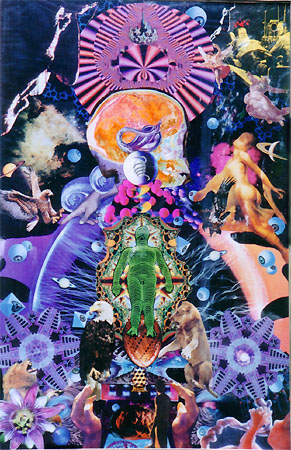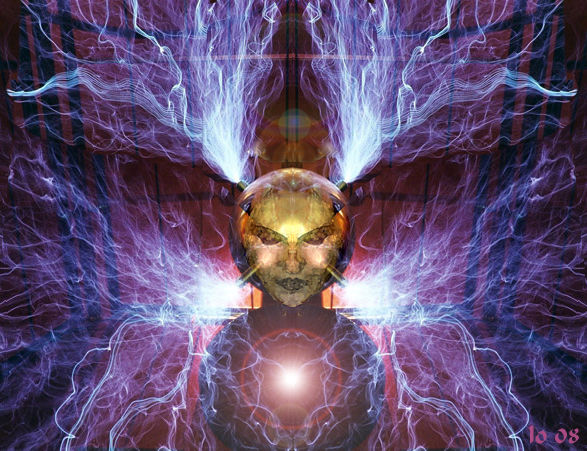Homunculus
Homunculus

THE HOMUNCULUS
In the ancient art of alchemy (another analog of the transformation process), the soul is depicted as a homunculus, or "small man." It was symbolically equivalent to the Philosopher's Stone, and the Elixer or Universal Medicine. This homunculus personified the unconscious as an Inner Man, a hermaphroditic being, a spirit in the bottle, a "brain child."
Zosimos and Paracelsus spoke of the homunculus as devouring himself, rending himself with his own teeth, like the Urobouros serpent which bites its tail and gives birth to itself. Both homunculus and uroborous are symbols of paradox. What an image of the dynamics of chaos and order, as it appears in experiential psychotherapy. The image typically appears before dissolution of the center into its unconscious element--the undifferentiated consciousness of the ground state.
The liquid form of the philosopher's stone is the called the "universal solvent," and chaos is certainly that. As such, it reflects the self--the prima materia, the massa confusa of the original chaotic state. Consciousness occurs in a continuum accompanying the flow of matter and energy in and through brains. Our apprehension of all of our experience is conditioned by our input channels, the sensory and extrasensory (or metaphorical) systems. Intuition is one such meta-sensory channel.
Walter Freeman believes that perception begins with an internally generated neural process that prepares the organism to seek future stimuli in the outside world. Between the experience and the input that triggers the experience, something is "added" to conscious experience by the transformational processes that lead from sense organ to brain. Invariant stimulus from the environment (physical space) arrives as information in sensory space and finally proceeds to cerebral space as meaningful input.
Experience is synchronized cerebral, sensory, and physical (survival) space-times. Meaning is a function of the level of arousal at which it is experienced. The symbolic interpretation of one's own central nervous system activity, the integration of information to systemic meaning depends on the level of arousal. Higher levels of arousal, and thus more complete withdrawl from physical space-time into cerebral space-time, narrow the field of attention and deepen the experience of meaning (Fischer, 1969).
Meaning results from integration of information within the systemic context of a self-referential, self-organizing system. The brain interprets this input, along with its own creative addition of (virtual) information, and creates a simulation of perceived reality. It is a convergence of the body sense of muscles and joints, the viscera, and the outward-looking senses.
Nerve signals from all over the body are sent to the thalamus, which has sections made up of neurons assigned to each body area. These signals are passed on to the neurons in the somatosensory cortex which contains the brain's own map of the body. Our experience and expectations are geared to our perceptions, which have a wide range of subjective interpretation. Consciousness is intimately linked with the sensory-motor cortex (parietal lobe).
The sensory cortex is typically "mapped" onto the brain as a small, distorted human figure called the "homunculus." Though they are analogous, the homunculus of alchemy (the soul) is not equivalent to the homunculus in the brain. Rather than the elusive "seat of the soul," the sensory homunculus is part of the "hardwired brain," a skin-map in the cortex. Yet it is implicated in the somatic part of spiritual experience. Each part of the sensory system is assigned a particular region in proportion to other parts.
Both sensory and motor cortices have about the same layout of corresponding points. The body is reflected in the cortex. [insert homunculus/brain diagram here]
A specific sensory to motor ratio is the reflection of the subjective and objective facets of our nature. With eyes closed we can experience the universe inside ourselves in sensory imagination, that is, subjectively. With eyes open we can change "what there is" outside ourselves through voluntary motor performance, that is, objectively. These experiential and experimental facets are implicit in the nature of self-referential, self-organizing systems.
Self-reference implies that the universe exists subjectively, that is, in reference to the self; self-organization, or goal seeking, refers to the ability to rearrange the outside universe (Fischer, 1967). There is the complementary notion in the medieval consciousness science of alchemy. In alchemy, the homunculus is sort of the primal test-tube baby to be created through a dynamic process in the Hermetically-sealed retort vessel.
Paracelsus alleged that the entity could be created from semen that is gently heated in the vessel for 40 days, then "magnetized." It feeds daily on the hidden mysteries of nature. Some of the ancient philosophers were said to have been begotten by this process. Jungian psychology reads this process as the creation of a renewal of spirit which takes place in the psyche when psychic contents are prevented from "leaking out" and being lost. "Heating" is symbolic of amplifying or intensifying the transformative process. In terms of chaos theory, "magnetizing" the entity might insinuate the formation of a strange attractor as the complex core of the system.
An attractor describes a temporary stability far from equilibrium. We can conceive of it as a polarization of gray matter. The homunculus is the archetype of the magical child. It is thus an embryonic symbol of rebirth, or re-creation of self by Self. In alchemy, the homunculus is generated by a succession of transformations through the four elements to reach its essential nature. The elements may be corresponded with the four arenas of human life: physical-earth; emotional-water; mental-air; spiritual-fire.
The homunculus mapped on the sensory cortex gives us access to this transformational system through the imagination. This phenomenon has been dealt with in yoga as kundalini, the serpent power. When it is activated there is a stimulus spreading along the sensory cortex of both hemispheres of the brain. Stimulus may be induced electrically, mechanically, or imaginally.
When induced through imagination, the experience is virtual in nature, yet just as "real," in terms of psychophysical results. A (real or imagined) stimulus moves along the cortex, setting up acoustical standing waves in the cerebral ventricles (Bentov, 1977). Vibrations that arise in the ventricles are conducted to the gray matter of the cortex which lines the fissure between the two hemispheres. These vibrations stimulate and eventually "polarize" the cortex in such a way that it tends to conduct a signal along the homunculus, usually beginning from the toes upward. This creates a stimulus-loop, unlike the normal input-output of normal signal processing.
When nerve cells interact, there is the seed of a bodily action within each pattern that arises through chaotic dynamics. Self-stimulation of the pleasure centers of the brain may be created by circulating a current along the sensory cortex. When body motion is involved, there is cross-talk onto the similarly-mapped motor cortex.
Standing waves can be induced mechanically through resonance by pulsating a magnetic field around the head at frequencies of 4-7 Hz (Theta), or through the auditory channel by eliciting frequency following response. Areas of stress in the body may produce symptomatic responses when stimulated through the homunculus. It usually appears as localized pain. Severity is proportional to the degree of stress encountered. Participants in process work report paradoxical sensations of hot-cold, and pleasure-pain. Pain and temperature are intimately related, and initiate experiences of suffering and comfort, chills and thrills.
"Heat and cold" are the archetypal guardians residing in the brain stem. These signals are processed in the amygdala of the limbic forebrain (frontolimbic system). Pleasure and pain are mediated by the ergotrophic (sympathetic nervous system) and trophotrophic (parasympathetic) systems of arousal, and their neurotransmitters, noradrenelin and serotonin. At their extremes, they paradoxically convert into their opposite.
Arousal and involvement with the outer world (action) is mediated by the ergotrophic system; tranquility and the inner world (contemplation, relaxation)) by the trophotropic system. Sympathetic nervous system activity involves goal-orientation, increased tone of striated muscles, cortical desynchronization, excitement of smooth muscles of the eye, heart, and vascular system, goose-flesh, inhibition of gastrointestinal activity, increase in adrenomedullary secretions, and rise in blood sugar.
Parasympathetic activity is characterized as satiety, decreased respiration, cortical synchonization (alpha, theta), inhibitory effects on smooth muscles of eye, heart, and vascular system, muscular relaxation, increased visceral activity, and fall in blood sugar. Hyperarousal can be symbolized as a Plenum; hypoarousal as a Void. When the sensory cortex is overwhelmed, it paradoxically switches to void-consciousness.
Paradoxes provide the dynamic for transcendental experiences and the attainment of creative consciousness. The shift takes place as we move from a sense of "I" or ego toward the transpersonal self, or no-boundaries condition. Pain and anxiety arise from an inability to verify the state of arousal through cortical interpretive models or voluntary motor activity. But in the bliss state, there is no separate "I" left to become anxious, feel pain, or "freak out." It is characterized by oneness with everything.
The paradox of the ergotrophic and trophotropic systems is that they not only represent the guardians or obstacles of spiritual paths, but they are also the paths themselves. Increased trophotrophic arousal represents a perception-meditation continuum which culminates in samadhi, while increasing ergotropic arousal represents a perception-hallucination continuum which culminates in ecstasy (Fischer, 1971).
Jung described a "full void" he called the pleroma as a source of Everything--a sense of vastness, of emptiness that is nevertheless ordering. In complex dynamics, ordering does not come from a single "somewhere" but from everywhere and nowhere--from the void that is full. The sensory/motor ratio may be increased either by enhancing the sensory component (overloading the nervous system with drumming, dancing, sweating, music, mental or physical stress), or by inhibiting the motor component.
<>The paradoxical shift happens because of sensory input overload coupled with motor activity impairment. In this meditative-like state, the brain produces endorphins and enkephalins which block pain perception and create feelings of well-being. The electronic signal is converted into a chemical messenger, forming the material basis of emotions (Pert, 1988).